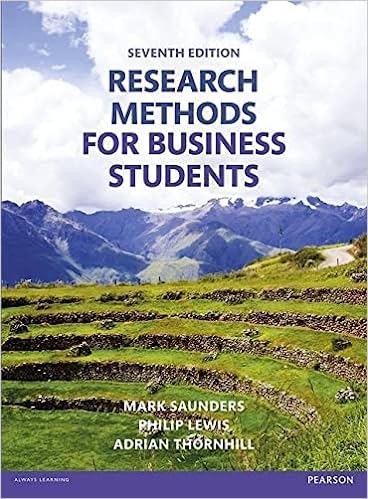Elena had carried out a successful research project. Following an in-depth review of the available literature she
Question:
Elena had carried out a successful research project. Following an in-depth review of the available literature she had utilised a diary method to investigate the causes and consequences of stress in academics working in two higher education organisations. Twenty individuals had completed daily entries over five consecutive working days. Obtaining this amount of data from these busy individuals was a testament to Elena’s concerted efforts and the professional manner in which she approached her research project.
While the diary method has been employed effectively in studies of occupational stress and wellbeing, it has been largely used in a highly quantitative fashion, and Elena’s free-response format was particularly innovative. The considerable amount of data generated could have been daunting but, once again, Elena dealt with this well. She developed a coding scheme to pull out key themes and representative quotations to ensure she fully capitalised on the benefits to be accrued by the use of her qualitative design.
Now Elena just had to write up her research project. She read her university’s requirements:
• Title page • Acknowledgements • Abstract • Contents page • Introduction • Literature Review • Methodology • Results • Discussion • References • Appendices In her usual methodical manner, Elena worked her way through the list of items.
However, this process took her considerably longer than she had expected. She sent Chapters 1–5 (Introduction, Literature Review, Methodology, Results and Discussion), together with her abstract, to her project tutor for comment. However, she still had a lot of work to do to put the whole project together. Elena realised that she had not taken sufficient account of how long her write-up would take and wished she had drawn more extensively on texts which considered the research process (e.g. Rudestam and Newton 2007). Given the deadline for submission was approaching, Elena now just hoped that the work she had sent to her project tutor would not require any kind of substantial change.
Elena’s project tutor replied with many supportive comments, in particular: ‘The literature review is well-written and details seminal and current material, which you have extensively drawn upon in order to locate the study in the context of previous research. The research design and specific research methods are coherent with the intended aims and you have appropriately endeavoured to make full sense of the study findings, using a sensible method of data audit and analysis.’ However, Elena was somewhat dismayed to receive the additional comments:
1 ‘Your abstract is rather vague and does not fully reflect your study.’
2 ‘It is rather disappointing that the scholarship evidenced in the early chapters is not seen in the Discussion (Chapter 5). Unfortunately, you have not exploited the data to make full sense of the study findings. The conclusions are rather broad and should have been more specifically tailored to the actual findings. Moreover, while methodological limitations are considered, there is insufficient reflection on these and others (e.g., self-selection of the study participants) and the implications that these might have had on any interpretations of the results. You will find Biggam (2008) a helpful text.’
Questions 1 What advice would you give to Elena to help her to produce a good abstract?
2 What is the main function of the Discussion chapter and what content should it include?
3 To avoid last-minute panic (as experienced by Elena), how would you ensure you had planned sufficient time for your project write-up?
Step by Step Answer:

Research Methods For Business Students
ISBN: 9781292016627
7th Edition
Authors: Mark N.K. Saunders, Philip Lewis, Adrian Thornhill





